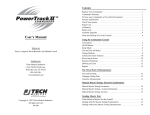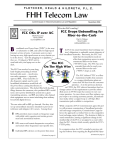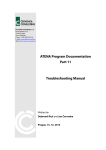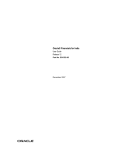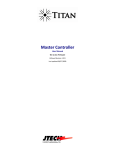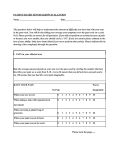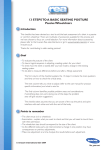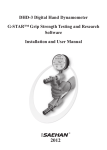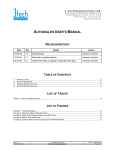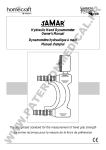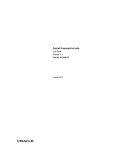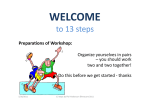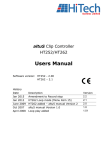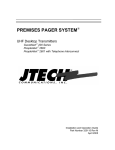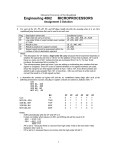Download The GripTrack Dynamometer
Transcript
User’s Manual Written by Tracy Livingston, David Bernardi, and Michael Carroll Published by JTECH Medical 470 Lawndale Drive, Suite G Salt Lake City, UT 84115 801-478-0680 www.jtechmedical.com Copyright © 2004 JTECH Medical All rights reserved. Part Nunber 685 Contents Commander Warranty . . . . . . . . . . . . . . . . . . . . . . . . . . . . . . . . .1 To have your Commander or GripTrack repaired . . . . . . . . . . . .1 Features and Benefits . . . . . . . . . . . . . . . . . . . . . . . . . . . . . . . . .2 Check Your System . . . . . . . . . . . . . . . . . . . . . . . . . . . . . . . . . .3 Proper Care . . . . . . . . . . . . . . . . . . . . . . . . . . . . . . . . . . . . . . . .3 Calibration . . . . . . . . . . . . . . . . . . . . . . . . . . . . . . . . . . . . . . . . .3 Battery Life . . . . . . . . . . . . . . . . . . . . . . . . . . . . . . . . . . . . . . . .3 Available Upgrades . . . . . . . . . . . . . . . . . . . . . . . . . . . . . . . . . . .4 Wrist and Desktop Use of the Console . . . . . . . . . . . . . . . . . . . .4 Using the Commander Console Conventions . . . . . . . . . . . . . . . . . . . . . . . . . . . . . . . . . . . . . . . .5 On/Off Button . . . . . . . . . . . . . . . . . . . . . . . . . . . . . . . . . . . . . .5 Setup Mode . . . . . . . . . . . . . . . . . . . . . . . . . . . . . . . . . . . . . . . .6 Test and Test Alt Modes . . . . . . . . . . . . . . . . . . . . . . . . . . . . . . .7 Testing Methods . . . . . . . . . . . . . . . . . . . . . . . . . . . . . . . . . . . . .8 Advanced Console Features . . . . . . . . . . . . . . . . . . . . . . . . . . .10 Reviewing and Exam . . . . . . . . . . . . . . . . . . . . . . . . . . . . . . . .10 Statistics Definitions . . . . . . . . . . . . . . . . . . . . . . . . . . . . . . . . .12 Deleting an Exam . . . . . . . . . . . . . . . . . . . . . . . . . . . . . . . . . . .12 Printing Reports . . . . . . . . . . . . . . . . . . . . . . . . . . . . . . . . . . . .12 The GripTrack Dynamometer Care and Cleaning . . . . . . . . . . . . . . . . . . . . . . . . . . . . . . . . . .13 Changing Handle Position . . . . . . . . . . . . . . . . . . . . . . . . . . . . .13 Using the GripTrack Dynamometer Grip Testing, When, Why, How Often . . . . . . . . . . . . . . . . . . . .13 The 5 Position Grip Test . . . . . . . . . . . . . . . . . . . . . . . . . . . . . .14 The Rapid Exchange Grip (REG) Test . . . . . . . . . . . . . . . . . . .16 General Grip Testing . . . . . . . . . . . . . . . . . . . . . . . . . . . . . . . . .18 Commander Warranty One-year Limited Warranty The Commander™ console and GripTrack™ transducer are designed to perform reliably and to meet specifications. In spite of diligence in manufacturing, eliminating malfunctions resulting from random component failure is impossible. Therefore, JTECH will at its option repair or replace the product with a new or reconditioned unit at no charge for a period of one year from the date of purchase. In view of the varied conditions in which the unit will be used, the Commander Console and GripTrack are sold “as is” and JTECH’s responsibility does not go beyond the terms set forth above. JTECH will not be responsible for medical expenses or any direct, indirect, or consequential damages arising from the use of this product. JTECH shall in no way be liable loss of revenue or profits resulting or alleged to result from use of this product. THIS WARRANTY IS MADE EXPRESSLY IN LIEU OF ANY OTHER WARRANTY, EXPRESS OR IMPLIED, INCLUDING AN IMPLIED WARRANTY OF MERCHANTABILITY OR FITNESS FOR A PARTICULAR PURPOSE. UNDER NO CIRCUMSTANCES SHALL JTECH BE LIABLE FOR ANY DIRECT, INDIRECT, INCIDENTAL, OR CONSEQUENTIAL DAMAGES. THE REMEDIES SET FORTH IN THIS WARRANTY SHALL BE THE ONLY REMEDIES AVAILABLE, EXCEPT AS SPECIFICALLY PROVIDED BY STATE LAW. NO PERSON HAS ANY AUTHORITY TO BIND JTECH TO ANY REPRESENTATION OR WARRANTY EXCEPT AS SPECIFICALLY SET FORTH HEREIN. To have your Commander or GripTrack repaired: 1. Contact JTECH Customer Service and describe the problem. After receiving a return authorization number, return the product to JTECH, including all accessories, postage paid and insured to JTECH. JTECH is not responsible for damages or losses incurred in shipping. 2. Submit proof of purchase and date. 3. Include a brief explanation describing the problem. Features and Benefits GripTrack™ Transducer: Uses standard gauge for comparison to published norms. Precision instrument with 97% force accuracy guarantee. TM Upgradable to Tracker computerized testing system. Commander™ Console: Easy-to-read 1.5” high LCD display. Operates during exams either as a wrist unit or as a desktop system using the included longer cable. Gathers, stores, and analyzes up to 25 bilateral grip strength tests, including up to eight repetitions per side. Calculates CV, fatigue, maximum force and average force for each repetition. Documents outcomes assessment with the automatic bilateral deficit analysis. Helps determine consistency of effort in workers compensation and FCE exams. Test now, record later because the exam is stored in memory, even when Commander is turned off. Automatic audio prompts examiner for the next test in the series and provides motivation during timed tests. Measures up to 200 pounds for very strong performers. Battery powered for portable operation. Test protocols can be customized according to number of tests, starting force, newtons/pounds, test time and number of repetitions. Check Your System Your GripTrack Commander system should include the following parts: Commander Wrist Unit GripTrack Dynamometer Short Cord Long Cord Worksheets Make sure the serial number on the GripTrack matches the serial number on the Commander Console. If these numbers do not match, call JTECH Customer Service. Proper Care With proper care your new GripTrack Commander will provide many years of worry free use. Do not immerse the dynamometer or the console in water, place in an autoclave or sterilize with harsh disinfectants. Clean the housings with a soft, non-abrasive cloth moistened with clean water. Clean the display using a non-abrasive dry cloth. Do not use cleaners. Avoid dropping the unit or banging it against hard objects. Do not stand on, apply more than 200 lb. of force, or use the dynamometer for anything other than grip strength testing. Failure to follow these policies will void the warranty. Calibration To ensure accuracy the GripTrack and Commander console have been factory calibrated with weights traceable to the National Institute of Standards and Technology. When turned on the Commander console automatically zero calibrates itself. Therefore, make sure no force is being applied to the dynamometer when the Commander console is turned on. Any force applied to the dynamometer when the console is turned on will become the zero value and will result in inaccurate force readings. Battery Life The Commander console uses a standard 9 volt alkaline battery. The estimated battery life is 28 hours of operation. The Commander console should always be turned off when not in use to maximize battery life. (The console will automatically shut itself off after four minutes of inactivity.) NiCad batteries can be used, however, the active battery life will be reduced to approximately eight hours or less. When using a NiCad battery, completely drain the battery before recharging to prevent “memory” in the battery that will further reduce battery life. Available Upgrades The GripTrack™ can be used with the following upgrade products: Easy Docs Plus - Create cutting edge reports using this versatile software package. With Easy Docs Plus, you can enter data from your GripTrack Commander and from other testing devices such as pinch dynamometers, inclinometers, goniometers and muscle testers. Tracker™ Software Package- GripTrack comes ready to plug into the leading Windows-based musculoskeletal evaluation software package. The package includes the Tracker Interface Box™ for connecting to a PC. The GripTrack™ dynamometer plugs into the “Grip” port of the Tracker Interface Box™ without any modifications. Tracker™ software automatically records test results, analyzes statistics, makes comparisons to previous tests during exams, works seamlessly with other Tracker diagnostic devices, and outputs data in a comprehensive report format. For more information on upgrades, contact your JTECH sales representative or call JTECH at 1-801-985-8324 or 801-478-0680. Wrist and Desktop Use of the Console The GripTrack Commander system comes equipped with two cords for connecting the dynamometer to the console unit. The short cord is used when the Commander console is strapped to the examiner’s forearm. The longer cord is used when the Commander console is placed on a desktop or left in the case during testing. The cords connect to the console and dynamometer with telephone-jack plugs. To remove a cord, press down on the cord-jack’s plastic release lever and slide the end out of the receptacle. When installing a cord, make sure the jack “snaps” securely into place. NOTE: If a cord is damaged or lost, do not attempt to replace with a standard telephone cord as the wiring is not the same. Contact JTECH Customer Service for the correct replacement cord. Using the Commander Console Conventions This manual adopts the following conventions throughout: Test Refers to one strength assessment that may include multiple repetitions and comparisons between the right and left side. For instance, testing grip strength at dynamometer position 2 with three repetitions for the right side and three repetitions for the left side is one test. Exam Refers to multiple tests. For example, testing grip strength before therapy and after therapy could comprise one exam. On/Off Button ON / OFF Press the button once to turn on, press again to turn off. Exams stored in memory are not erased when power is turned off. Pressing this button and holding for two seconds deletes stored exams. (For information about deleting tests, see Advanced Console Features on page 10.) The console will shut off automatically after four minutes of inactivity. Note: Make sure no force is applied to the dynamometer when turning the console on. When the console unit is turned on it will activate in either “Test” mode or “Review” mode, depending on whether an exam is stored in memory. If no exam is stored in memory the console will activate in Test mode ready for test #1. The active “mode,” in this case “TEST,” is displayed in this area. Test and repetition numbers are shown here. Side being tested is displayed on this line. Real-time force on dynamometer can be shown in pounds or newtons. Testing Mode If an exam is in memory when the console is turned on, Commander activates in “Review” mode. From this point you can review exam data, change to “Test” mode to finish testing, or delete the exam. See the appropriate headings below. Setup Mode Testing Defaults The Commander console enables you to use the “Setup” mode to control a variety of test parameters, such as the testing threshold, number of tests, test time, number of repetitions per test, and force readings in pounds or newtons. Once test parameters are set, they become the defaults for the console. For example, if you set the number of repetitions to three, then the unit will test for three repetitions per side for every exam until you change the default. Default settings do not change when the unit is turned off or when an exam is deleted. Defaults can only be reset manually. Setting Defaults Three buttons are used when setting console defaults: SETUP, SELECT, and CHANGE. The buttons function as follows: SETUP: Press this button until “Setup” is displayed at the top of the LCD. It is also used to exit “Setup” after setting parameters. SELECT: Use this button to advance and select the parameter to be changed. CHANGE: This button changes the parameter setting. Press this button until console is in “Setup” mode. After parameters are set, use this button to exit back to “Test” mode. While in “Setup” mode, use this button to advance through parameters. When a parameter is displayed, use this button to change the default setting. Adjustable Defaults The GripTrack Commander console allows you to control the following default parameters: THRESHOLD: Determines the amount of force that must be exerted against the dynamometer before the console begins recording data. This setting is used to avoid inadvertently beginning a test. It can be set at 3, 5, 10 or 20 pounds. TEST TIME: Determines the length of a sustained test in seconds. During the test the buzzer sounds. The test ends when either the allotted time expires or the force drops below the threshold value. Test Time can be set from 1-5 seconds or to “blank” for untimed tests. TEST: Controls the number of tests available for an exam. The console automatically goes into “Review” mode when the number is reached. It can be set from 525 in increments of five. REP: Sets the number of repetitions per side per test. It can be set from 1-8. Set Rep to a maximum of five for an REG test and to 4 or less for 5 position and general grip tests. A minimum of two repetitions is required for CV calculations. LBS (N): This parameter controls whether force readings are in pounds or newtons. Test and Test Alt Modes Tests are conducted using either the “Test” or “Test Alt” modes. (How the modes are used is described below.) To conduct a test, apply pressure on the dynamometer. Test recording begins when the default threshold force is exceeded. A test ends when test time expires or the force on the dynamometer drops back below the threshold. The display then indexes to the next repetition in the series. After all repetitions for a test are completed, the display indexes to the next sequential test number. Continue testing with this method until all tests are recorded in memory. Repetitions for a Test The Commander console can record and average up to eight strength repetitions per side for each test. The repetition order is selected by either of two methods: Same Side Repetition Order: When “Test” mode is displayed, the unit prompts for all right side repetitions first, then all left side repetitions. For example, if the default is two repetitions, the test sequence in “Test” mode is: TEST 1 REP 1 RIGHT TEST 1 REP 2 RIGHT TEST 1 REP 1 LEFT TEST 1 REP 2 LEFT TEST 2 REP 1 RIGHT TEST 2 REP 2 RIGHT ....etc. Helpful Hint: If unilateral testing is required, the right side can be tested and the left side skipped by pressing the “NEXT” button, or the right side can be skipped by pressing “NEXT” and testing the left side. Alternating Sides Repetition Order: When “Test Alt” mode is displayed, the repetitions alternate between right and left side as follows: TEST 1 REP 1 RIGHT TEST 1 REP 1 LEFT TEST 1 REP 2 RIGHT TEST 1 REP 2 LEFT TEST 2 REP 1 RIGHT TEST 2 REP 1 LEFT ....etc. This method can be used for rapid exchange testing (see page 16) or if submaximal effort is indicated. By mixing up the left and right side routine, the subject may have a more difficult time repeating the results on each side as indicated by the coefficient of variation. Testing Methods The Commander console can store up to 25 tests in memory complete with data for all repetitions and statistics. In order to easily record multiple tests the Commander uses Automatic Indexing™. This method automatically indexes the display to the next test in the series without requiring you to press any buttons. For example, after completion of all right and left side repetitions of test 1, the display indexes to TEST 2 REP 1 RIGHT. NOTE: After completing a test, Commander prevents inadvertent deletion of tests previously stored in memory by indexing to the next test not completed. For example, if test 2 was completed previously, after test 1 is completed Commander will skip test 2 and index to test 3. Sequential Testing Method This method always begins with handle position 1 (test 1) and uses Automatic Indexing™ to proceed from handle position 1 to handle position 2, etc. Mark the results on the exam worksheet corresponding to the test numbers from the display. When sequential testing and automatic indexing are used with a 5 position grip test, test 1 indicates grip position 1, test 2 indicates grip position 2, etc. (In position 1 the adjustable grip handle is in the closest position to the gauge.) Using this method the entire 5 position test, including three repetitions at each position, can be quickly completed without touching the Commander console. (See 5 Position Grip Testing on page 14.) In this example, test 1 would correspond with the GripTrack handle in position 1 (closest position). NOTE: When performing a rapid exchange grip test (REG) as a validity check following a 5 position test, the REG becomes test 6 in the sequence. (See Rapid Exchange Grip Testing on page 16 for complete console settings.) Helpful Hint: Since the display indexes past old tests stored in memory, this method is recommended only if all previous tests have been erased. Assigned Testing Method This method is used for single position grip tests and for REG tests. Therefore, Automatic Indexing™ should not used with this method. Instead, select test numbers on the Commander unit by pressing the “NEXT” button until the display’s test number matches the grip gauge handle position. In this example, the test number on the display corresponds to grip handle position 3, the third position out from the handle. Helpful Hint: You should be careful to select the proper test number before starting a test, and be extremely careful not to inadvertently continue with the next automatic test in the series. If you inadvertently begin a test at the next test number because of Automatic Indexing™, delete the test by pressing “REVIEW” and holding it while you press “Redo.” Advanced Console Features REDO REVIEW NEXT REDO REVIEW TEST CONT. REDO Press “REDO” to test the last repetition again. This feature is helpful if the current test was started inadvertently, was done incorrectly or was for practice. Redo or delete other tests - Press “REVIEW” then press “NEXT” until the correct test number is displayed. While holding the “REVIEW” button down, press “Redo.” The entire test, including all right and left side repetitions, will be deleted. Then redo all repetitions for the deleted test. Important Note: When using “REDO” for a test, the entire test, including repetitions for the right and left side, are deleted. Once a test is deleted it cannot be recovered later. Review last repetition - To review the measured force for the last repetition, press “REVIEW” after the repetition is complete. To review other statistics associated with the test, continue pressing “REVIEW,” and the display will scroll through all available statistics. To continue testing with the next repetition, press “TEST CONT.” To erase the repetition and start over, press “REDO.” Reviewing an Exam REVIEW NEXT REVIEW An exam can be reviewed at any time, either during testing or after, by pressing the “REVIEW” button. The last completed repetition will be displayed. To review other tests within the exam, press “NEXT” to advance to the next test with recorded data. When advancing through tests, the Commander display shows the test number with the right side repetition. To see left side repetitions and additional statistics press “REVIEW.” Statistics To scroll through and review all the statistics for the displayed test, continue pressing “REVIEW.” Press “Next” to view statistics for the next test. In the following example, the statistics for test 2 are displayed in the order they will appear by pressing “REVIEW.” For the example on the next page, the number of repetitions was set at two: REVIEW Maximum force right side repetition 1 REVIEW Average force for right side repetitions Maximum force right side repetition 2 REVIEW REVIEW REVIEW Fatigue for right side (Only displayed for timed tests) CV for right side Maximum force left side repetition 1 REVIEW REVIEW Maximum force left side repetition 2 REVIEW CV for left side Average force for left side repetitions REVIEW After all statistics have been selected, the display circles back to the beginning. REVIEW Fatigue for left side (Only displayed for timed tests) Bilateral deficit left side To view the next test, press “NEXT.” The display indexes only to test numbers with data. Statistics Definitions LBS: In “Test” and “Test Alt” modes LBS displays force against the dynamometer in real-time. In “Review” mode, LBS shows maximum force that was applied to the dynamometer for the displayed repetition. AVG: The average force of all repetitions for the indicated side. % CV: The coefficient of variation for all the repetitions for the indicated side using the n-1 method. % Fatigue: Calculated only for timed tests using the highest force repetition for the indicated side. Fatigue shows the reduction in force at the end of a timed test compared to the maximum force reached during the same test. For example, if the maximum force reached is 100 lb. and the force at the end of the test is 80 lb., the fatigue is 20%. The fatigue formula is: 100 - 80 x 100 100 Note: If test ends before test time expires, Fatigue will be 100% %Deficit: Bilateral deficit indicating weakness of one side compared to the other. Deleting an Exam To erase an exam, turn the Commander console on, then press and hold the on/off button for a minimum of two seconds, or until the unit reactivates. The unit will beep and turn off indicating data has been erased. Note: All test default values will be retained. Reports GripTrack Commander comes with a worksheet tablet that enables you to manually document test results. In addition, computerized reports can be created from GripTrack Commander data using optional Easy Docs Plus software from JTECH Medical. For more information on Easy Docs Plus, contact JTECH Medical sales at 800 985-8324 or 801 264-1001. The GripTrack Dynamometer Care and Cleaning GripTrack is an electronic device and, therefore, should not be submerged in liquid or placed in an autoclave. The device should be cleaned with a soft, non-abrasive cloth dampened with clean water. Do not use solvents, detergents or harsh disinfectants on the GripTrack handle. When not in use the device should be stored in the case provided. Avoid dropping or banging the device against hard objects. Never stand on, pound with or apply more the 200 lb. of pressure against the dynamometer. Changing Handle Positions The GripTrack dynamometer handle adjusts quickly and easily. To change the handle position: At the logo end of the dynamometer, flip the retaining clip off the slotted piston arm and slip the handle out of the slots. Place the vertical slot in the new position slot, then rotate the horizontal handle slot into the corresponding position slot on the other piston arm and flip the retaining clip into position. Important: The grip handle can only be installed in the proper orientation. Make sure the horizontal (sideways) handle slot is at the logo end of the dynamometer. Always secure the handle with the retaining clip before using. Using the GripTrack Dynamometer Grip Testing: When, Why, How Often? There are many reasons to measure a patient’s grip strength. In worker’s compensation cases, it may be necessary to establish if the patient can return to work. Grip strength can also be used to determine the nature of injury (organic versus psychological) or the patient’s sincerity of effort, as in a functional capacity evaluation. As part of a screening, comparing a subject’s strength relative to a normative database may be desirable. As part of a post-offer, grip strength may be used to determine an employee’s predisposition to repetitive motion disorders. With insurance companies requiring documentation of improvement, grip testing new patients to establish a baseline from which to assess treatment effectiveness (surgical, chiropractic or otherwise) may also be helpful. As part of a functional capacity evaluation, the 5 position grip test is the minimum grip strength testing that should be performed. The rapid exchange grip (REG) test and the sustained grip test should be performed if there is any question about sincerity of effort resulting from the 5 position test. A recently published rehabilitation protocol for patients with carpal tunnel syndrome suggests that grip strength testing should occur as part of an initial exam, which also includes orthopedic and neurological tests, nerve latency tests, range of motion, and X-ray. This test could be as simple as a position 2 maximum effort test or a complete 5 position test. The article also suggests that after two weeks of intensive care treatment the patient’s grip strength should be re-tested. After 6-8 weeks of rehabilitation care, the grip strength should again be tested. Upon discharge of the patient, or release to pre-injury status, a final grip strength should be performed. The 5 Position Grip Test The GripTrack Commander gives you the flexibility to perform a test at any or all of the 5 positions available with the dynamometer. The two most common test methodologies are: 1) a complete 5 position test to be used as a validity check or as part of a functional capacity evaluation, and 2) a simple position 2 or position 3 maximum grip test as part of a routine musculoskeletal evaluation. According to the American Society of Hand Therapists (1981) and Mathiowetz et al. (1984), the proper positioning of the patient for this test is as follows: Seated, with the shoulder adducted and neutrally rotated, elbow flexed at 90°, forearm in neutral position, and the wrist between 0 and 30° extension and between 0 and 15° ulnar deviation. In all cases, the arm should not be supported... The dynamometer is presented vertically and in line with the forearm to maintain the standard forearm and wrist positions. Commander Setup Before you begin a 5 position test setup the Commander console as follows: 1. Clear any previous tests from the memory by holding the “On/Off” button down for two seconds. 2. Make sure REP (repetitions) is set at three and TEST TIME is set to “blank” (see page for setup information.) NOTE: When using the Reporter printer, setting the number of repetitions to five or more will cause the test to be incorrectly labeled as a rapid exchange test. 3. Set the dynamometer to grip position 1. The Commander console will begin a test 1 for the right side and prompt for repetitions and new test positions. 4. Select “TEST” or “TEST ALT” method. “TEST” is the default, which tests first the right then the left for each grip position. “TEST ALT” alternates repetitions between the right and left hand. Patient Instructions Use the following standard instructions and verbal prompts developed by Mathiowetz and associates (1984) for performing the test: 1. Tell the patient, “I want you to hold the handle like this and squeeze as hard as you can.” 2. Demonstrate position and procedure, then give the dynamometer to the patient. 3. After the patient is positioned appropriately, say “Are you ready? Squeeze as hard as you can.” 4. As the patient begins to squeeze, say “Harder!...Harder!....Relax!” 5. Repeat the test two more times, then move on to the other hand. Using the Worksheet for 5 Position Grip Tests The worksheet can be filled out after all the repetitions for all five handle positions are completed or following the REG test. (For more information about the REG test, see below.) The worksheet provides space for entering in all the data and statistics recorded by the Commander console. Commander Grip Strength Report TM Name: ________________________ Date: ___________ Examiner: ________________________ Right Pos REP1 REP2 REP3 Left AVG %CV %FAT Pos REP1 1 2 2 3 3 4 4 5 5 REP2 REP3 AVG %CV %FAT % DEF Average (AVG) Force 1 Average (AVG) Force The worksheet also provides a graph for plotting the averages from each side for each handle position. Stokes (1983) and Janda et al. (1987) reported that a patient giving maximum effort at all five settings should produce a bell-shaped curve. This applies to injured and uninjured populations alike. It is based on the mechanical advantage unique to each test position. Plotting the averages provides an indication of the patient’s performance on the 5 position test. If the data is indicative of the characteristic curve , the patient can be said with reasonable certainty to have given valid effort and the test should be labeled as such. 4 5 3 1 2 Grip Position Setting Rapid Exchange Test (REG) Pos: ___ Right Left Rep 1 _________ _________ Rep 2 _________ _________ Rep 3 _________ _________ Rep 4 _________ Rep 5 _________ Rep 6 _________ _________ Rep 7 _________ _________ Rep 8 _________ _________ 4 5 3 1 2 Grip Position Setting Consistency of Effort CV < 15%? ______ of ______ (1) Maximum Voluntary Effort Bell-shaped curve (R)? Yes No (2) Bell-shaped curve (L)? Yes No REG < 5 pos. max. (R)? Yes No (3) _________ REG < 5 pos. max. (L)? Yes No _________ (1) Determine the number of tests performed, and the number that had a CV less than or equal to 15%. (2) Plot the average force value for each position versus setting. The plot should resemble a bell curve with a peak at position 2 or 3. (3) Compare maximum effort during REG test with maximum effort during corresponding 5 position test. REG values should be less. The graph serves as a maximum voluntary effort check for the overall 5 position test and should not be confused with the validity check used for the individual test positions. Coefficient of variation, displayed on the console and on the Reporter printout, is used to determine the consistency of effort for all the same-side repetitions at the specified handle position. Several CV values greater than 15% may indicate inconsistency of effort. Footnotes: 1. 2. 3. 4. “%FAT” corresponds to fatigue over duration of repetition. It is only calculated for timed tests. See Mathiowetz et al., Grip and Pinch Strength: Normative Data for Adults, Arch Phys Med Rehabil 1983; 66: 69-74, for grip strength protocols and normative data. “AVG” is the average of performed repetitions, “%CV” is the coefficient of variation for performed tests (minimum of two repetitions required). “%DEF” is the deficit percentage existing between right and left side tests based on bilateral comparison of maximum force values. Copyright © 1997 JTech Medical Industries. To reorder call JTech Customer Service @ 1 800 985-8324 The Rapid Exchange Grip (REG) Test Hildreth et al. (1989) showed that the rapid exchange grip (REG) test could be used as another validity check to supplement the 5 position grip test. In the event that the bell-shaped curve generated by a maximally-performing injured hand is somewhat flat, or an uncooperative patient produces a mildly bell-shaped curve, the REG can serve as a distinguishing maximum voluntary effort test. According to Hildreth, a patient should be suspected of submaximal effort if the greatest force recorded during the REG exceeds the maximum force seen in the 5 position test at the same handle positiion. The reason for this is theorized to be the short period of time the patient has to process the complex feedback of signals sent to the central nervous system involving frequency of neuronal firing and number and types of motor units required. The REG test is performed at the position in which the patient achieved maximum load during the 5 position test. REG Test Setup The REG test can be performed following a 5 position grip test without having to erase or record the 5 position data. However, the Commander console setup must be changed to provide the correct number of repetitions. Use the following instructions to set up the Commander console: 1. Set the dynamometer grip handle to the position where the highest force value was recorded for the 5 position test. 2. Enter “Setup” mode and set the number of repetitions to eight, select “TEST ALT” and make sure “TEST TIME” is set at blank. 3. Make sure the display is set for test 6 and is starting with the right side. Patient Position and Instructions The proper positioning of the patient for this test is as follows: Seated, with both shoulders adducted and neutrally rotated, elbows flexed at 90°, forearms in neutral position, and the wrists between 0 and 30° extension and between 0 and 15° ulnar deviation. In all cases, the arms should not be supported. The dynamometer is presented vertically, and held by the examiner equidistant between the patient’s hands at a height to maintain the standard forearm and wrist positions. The examiner should hold the dynamometer by the pressure dynamometer and present it to the patient as shown on the next page. Starting the REG test with the right hand Use the following standard instructions for performing the test: 1. Tell the patient, “Starting with your right hand, grasp the dynamometer and squeeze as hard as you can. Switch your hands as rapidly as possible, and squeeze maximally with your left hand. We will repeat this ten times. Remember to exert maximal force and alternate you hands as quickly as possible.” 2. Demonstrate and then give the dynamometer to the patient. 3. After the patient and dynamometer are positioned appropriately, say “Are you ready? Begin.” 4. As the patient begins to squeeze, say “Quickly!...Quickly!” 5. A minimum of five repetitions is required for a validity determination. The Commander console will prompt for eight, but the test can be ended anytime after five. 6. Graph results on the worksheet. General Grip Testing In order for a grip test to be used as a validity check, a minimum of two repetitions must be performed bilaterally. Additionally, to obtain fatigue data the test must be timed (see Setup Mode on page 7). Validity is based on the coefficient of variation (CV) of the completed repetitions for the hand and grip position. Generally, CVs greater than 15% denote inconsistency of effort. If a strength deficit greater than 15% exists bilaterally, weakness is indicated. For proper documentation purposes, make sure that the grip position corresponds with the test number selected on the Commander Console.





















